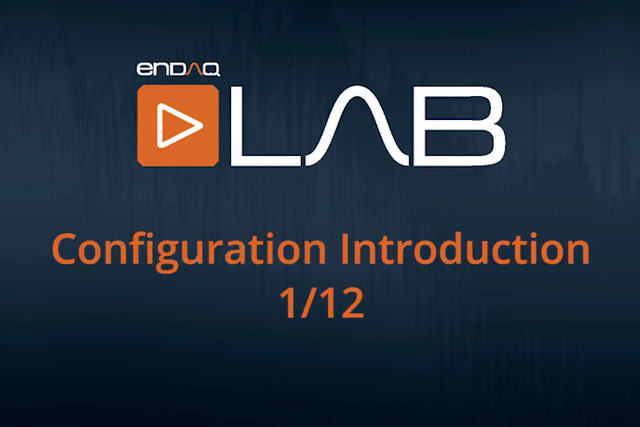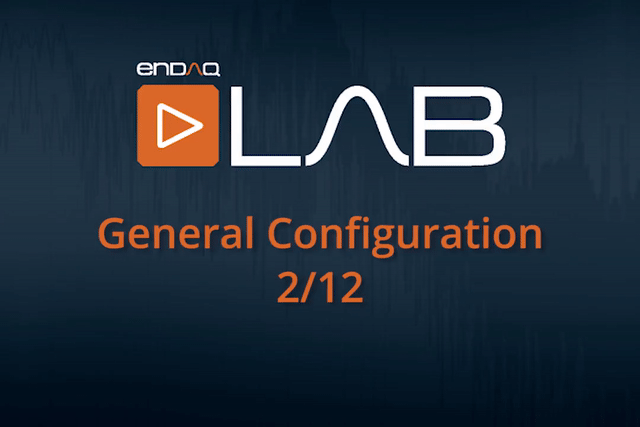Configuration Overview
enDAQ sensors are capable of being configured to specific measurement settings based on user application or preference. As such, there are a large number of different configuration options available to the user.
In this Article
Getting Started with Configuration

To open up the configuration settings window in enDAQ Lab, a user will do the following with enDAQ Lab open on a computer and the enDAQ sensor plugged-in to the same computer:
1. From the “Device” menu in the enDAQ Lab's menu bar, select “Configure Device”

Alternatively, you may click the Configure a Recording Device button on the enDAQ Lab splash screen.
2. Select the Device

Note
Please note that hardware 2.0.0 or newer will require enDAQ Lab 3.0.7 or newer.
3. Configure your Device!
Set the various parameters and hit okay to apply to your device. Note that the specific items shown depend on the model of recorder being configured, so the contents of your configuration dialog may vary slightly from what is shown here.

Note
Please note that the button still needs to be pressed to initiate the recording or triggering sequence after configuration, unless the recording is started through the enDAQ Lab USB interface.
General Configuration Settings

In the general configuration tab, there are a number of options that apply to the overall operation of the device (not sensor/channel specific). As previously noted, the specific options shown may vary slightly, depending on the model of recorder being configured.
Device Name
A custom name for the device, this does not change the volume label but would appear in the configuration screen. This is limited to 64 characters.
Device Notes
A 256 character field open to describe the location of the device or anything else helpful for future reference.
Custom Recording Tags
These are only visible when files have been uploaded to the enDAQ Cloud. These allow you to automatically categorize and group files based on your preferences.
Recording Directory
This feature allows you to name the folder where your recordings will be saved. This folder will be located within the DATA folder on the device.
Recording File Prefix
This allows you to add a prefix to your recording names. If blank, the device's serial number will be used. There is a 16 character maximum.
File Name Style (Option removed in Firmware 3.1 - Device defaults to Serialized)
This allows you to select between:
- Time Based
- Serialized
Plug-in Action (Option removed in Firmware 3.1 - Device defaults to Ignore)
If a recorder is being used in an application where direct access to the device during use is not possible, setting the plug-in action configuration will allow a user to end a recording remotely or switch the device to USB power. This configuration setting currently has three (3) available options:
- Immediately stop recording and appear as
USB drive - Complete recording before appearing as
drive - Ignore: Stop recording when
button is pressed - Start recording when USB connected (USB Download mode can still be selected by using the button to cancel the recording)
These settings will determine what the recorder does when it is plugged into a computer and therefore requires a USB cable to be connected to the recorder to
Button Mode
This allows you to select between:
- Immediate Start/Stop
- One Second Button Press for Start/Stop
- Start Only
In some applications, there is a risk of an inadvertent button press stopping a recording prematurely. You can select either a "One-Second" or a "Start Only" button press. The "One-Second" option requires the button to be held for a full second to start or stop a recording. The "Start Only" option can only be stopped by plugging the device into USB power unless there is a time limit or file size limit is set on the trigger screen. This option can only be used when the device is not plugged into an external power source if there are no time limits or file size limits set.
Local UTC Offset
The UTC offset refers to the time offset between the user’s time zone and the Coordinated Universal Time UTC). Selecting “Get Local UTC Offset” will automatically set the time offset between the user and the UTC.
Check Clock Drift
This references the internal clock to the computer's clock and outputs the delta. This can be useful for longer tests and the engineer wants to understand if any drift occurred to potentially compensate in post-processing.
Import... and Export...
A device's configurations can be saved out as an .xcg file. This file can then be imported onto another recorder to create an identical setup, or onto the same recorder to restore a specific configuration. Note: options specific to an individual device, such as the name, description, or user-edited calibration polynomials, are not transferred via .xcg file.
Import and export of configuration is only supported for devices with firmware released after 2018.
Advanced Settings
Setting Triggers
Every enDAQ sensor is capable of being configured to initiate a recording from a trigger condition. These triggers include simple time-based ones (record every 10 minutes for 1 minute or wake up at 08:00) or sensor-based ones (record once a 5g shock event has occurred). For more information visit the setting triggers article.
Measurement Settings
enDAQ sensors contain a variety of sensors, each with user selectable sample rates. Certain sensors can also be completely disabled to preserve battery life and/or reduce storage and processing needs. For more information, visit the measurement settings article.
User Calibration
All enDAQ sensors are calibrated before leaving the facility, but this calibration is fully exposed to the user and can be adjusted. To understand more how this calibration is determined and to adjust it, visit the user calibration configuration article.
Simulating a Recorder
If you don't physically have a recorder but want to do some configuration testing you can simulate one by complying the SYSTEM folder onto a USB drive. This will let the LAB "see" it as a recorder.
